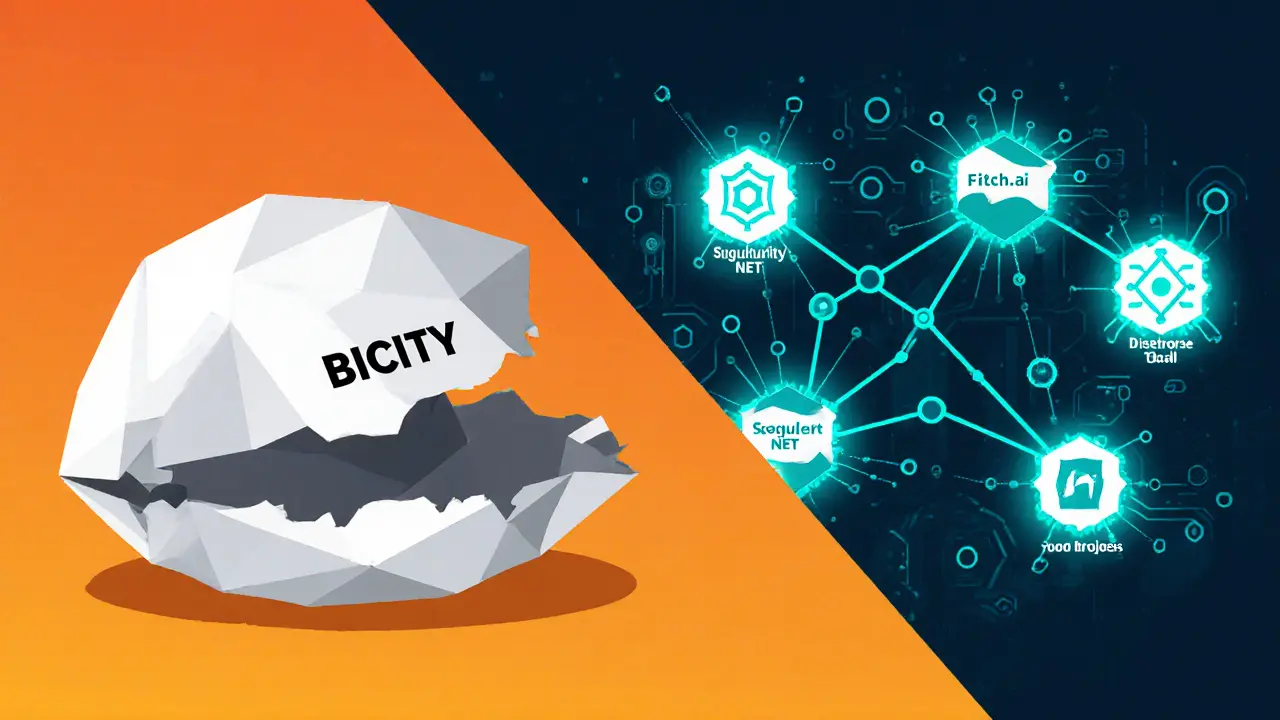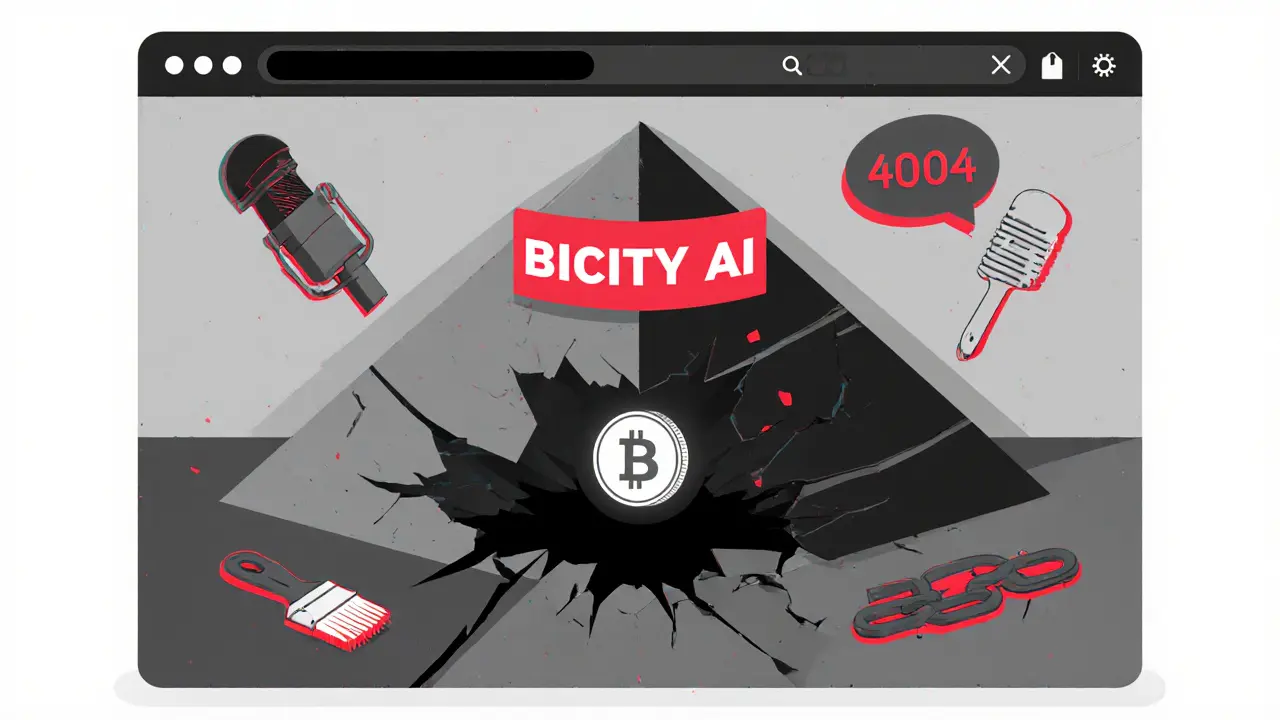Crypto Investment Loss Calculator
Investment Loss Calculator
Calculate how much money would be lost if you invested in BICITY at its peak versus current price.
Your Investment Loss
Important Warning: This calculator demonstrates the extreme risk of investing in unproven cryptocurrencies like BICITY. The project has collapsed entirely with no working platform, no team transparency, and no audits. Such investments are often pump-and-dump schemes that result in total loss.
Comparison to Real Projects
BiCity AI Projects (BICITY) was marketed as a blockchain-powered AI content tool for creators-text, images, audio-all powered by its own token. But today, it’s a ghost town. The coin peaked at nearly $1 in June 2024. Now? It’s worth $0.00038. That’s a 99.96% drop. And the platform it promised? Still not working.
What BICITY was supposed to be
BiCity AI Projects claimed to solve a real problem: AI content tools are expensive, and most don’t verify who actually created what. BICITY said it would fix that. Using AI algorithms, users could generate articles, images, voiceovers, and music. Every piece of content would be recorded on the blockchain, proving it was original and owned by the creator. The BICITY token would pay creators for their work and let them access premium AI features.
It sounded like a smart idea. Especially for small creators and freelancers who can’t afford Midjourney or Runway ML. The pitch was simple: democratize AI. But ideas don’t matter if the product doesn’t ship.
What happened to the price?
The BICITY token launched in mid-2024. Early buyers got a 5% bonus. Within weeks, the price hit $0.9658. People started posting about it on Reddit and Telegram. The hype was real.
Then, it crashed. Hard.
By October 2025, BICITY trades at $0.0003807. That’s less than half a cent. The 24-hour trading volume? Just $65,215. For comparison, Fetch.ai (FET), a real AI crypto project, trades over $100 million daily. BICITY doesn’t even register on the same radar.
There’s no recovery in sight. Price predictions say it could drop another 25% by the end of November. The 200-day moving average is at $0.000646-BICITY is trading well below it. This isn’t a dip. It’s a collapse.
The platform doesn’t work
Here’s the kicker: the AI tools you were supposed to use with BICITY? They don’t exist.
Users on Trustpilot and Reddit report the same thing: the demo links are broken. The web app won’t load. The mobile app? Never launched. One user, CryptoWatcher2025, wrote: “Tried to use their AI tools but the demo link on their website is broken since August.” That was months ago. Still broken.
The website, bi-city.ai, gets barely 3,200 monthly visits now-down 67% from its peak. The official Telegram channel has 2,347 members. The last meaningful update? July 2024. That’s over a year of silence.

No team, no code, no audits
Who built this? No one knows. The team is anonymous. No LinkedIn profiles. No public founders. No press releases from real people.
And there’s zero technical transparency. No GitHub repositories. No API docs. No smart contract audits. Independent crypto analysts on Reddit flagged this as a red flag. One user wrote: “No evidence of smart contract audit for BICITY-extremely risky for investors.”
That’s not just sloppy. That’s dangerous. Without an audit, you have no idea if the token can be drained, frozen, or manipulated. And with no public code, how do you know the AI even works?
Compared to real AI crypto projects
BiCity isn’t alone in the AI crypto space. But it’s at the bottom of the barrel.
Fetch.ai (FET) has a $1.8 billion market cap. SingularityNET (AGIX) partners with the UAE government. Ocean Protocol (OCEAN) lets users sell AI data securely. All of them have active developer communities, public roadmaps, and regular updates.
BICITY has none of that. No GitHub. No developer forums. No Discord with engineers. Just a website with broken links and a token that’s lost almost all its value.
Even Mubert, a crypto project focused only on AI-generated music, has $1 million+ in daily volume. BICITY claims to do audio too-but no one’s using it.
Why people still trade it
So why does BICITY still trade at all?
Because some people are still gambling.
It’s listed on Bitget, MEXC, and HTX-three smaller exchanges that list low-cap tokens with no real fundamentals. These aren’t places where institutions invest. This is retail speculation.
Chainalysis data shows 98.7% of BICITY trades happen on decentralized exchanges. That means almost no big players are involved. It’s just people hoping for a miracle pump.
And there’s still a tiny group of early buyers who bought in at $0.01 or less. They might be holding, hoping for a rebound. But even they’ve lost over 99% of their peak value.

The real danger: pump-and-dump
BiCity AI Projects ticks every box of a classic pump-and-dump scheme:
- Massive price surge with no product
- Anonymous team
- No audits or code
- Broken website
- Unresponsive support
- Unreported circulating supply (CoinGecko says “data not available”)
CoinDesk’s “Red Flags in Low-Cap Crypto” report from September 2025 specifically calls unreported supply a sign of potential fraud. If you don’t know how many tokens are in circulation, you can’t calculate the real market cap. That’s not transparency-it’s obfuscation.
And the affiliate program? Users say referral bonuses disappeared. Promised 100% BICITY rewards for referrals? Gone. No explanation. No refunds.
Should you buy BICITY?
No.
Not because it’s “too risky.” Because there’s nothing left to risk.
The project is dead. The tools don’t work. The team is gone. The community has vanished. The token’s value is a fraction of a cent.
Buying BICITY now isn’t an investment. It’s throwing money into a black hole hoping someone else will pay you more later. And with no product, no team, and no future, that’s not speculation-it’s gambling.
If you’re looking for AI crypto projects with real potential, look at Fetch.ai, SingularityNET, or Ocean Protocol. They have teams, code, audits, and users. BICITY has a website with broken links and a price chart that looks like a cliff.
What’s next for BICITY?
Nothing.
Delphi Digital’s October 2025 report calls BICITY a “low-probability survival” project. Messari’s 2026 Crypto Theses lists it among “zombie projects”-tokens that keep trading but have failed to deliver anything real.
The last update was in July 2024. The roadmap? Stalled. The promises? Unfulfilled. The token? Worthless.
There won’t be a comeback. There won’t be a revival. And if you’re still holding BICITY, you’re holding a digital ghost.

Kelly McSwiggan
November 14, 2025 AT 17:01So BICITY’s basically a crypto zombie with a PowerPoint deck and a Telegram group that hasn’t posted since 2024. The 99.96% drop isn’t a correction-it’s a funeral. And the fact that the ‘AI tools’ don’t load? Classic rug pull morphology. No audits, no code, no team. Just a whitepaper written by a GPT-4 bot with a grudge against capitalism.
Chainalysis says 98.7% of trades are on DEXs? That’s not liquidity-that’s a hamster wheel for retail suckers. The only thing this coin is generating is grief.
And yet… someone’s still trading it. Why? Because hope is the last thing to die. Even when the corpse is cold.
Also, the affiliate program vanished? That’s not a bug. That’s the exit strategy.
Byron Kelleher
November 16, 2025 AT 16:36Man, I feel bad for the people who got caught up in this. I mean, the idea sounded cool-democratizing AI for creators? Yes please. But you can’t just slap a token on a broken website and call it innovation.
There’s a difference between being optimistic and being naive. BICITY didn’t fail because the market turned-it failed because nobody bothered to build anything. That’s on the team. Not the investors.
Still… I hope whoever was behind this learns something. Maybe next time, ship the product before the hype train leaves the station.
Cherbey Gift
November 18, 2025 AT 06:24Ohhhhh sweet celestial chaos-BICITY is the crypto equivalent of a ghost town where the last resident is still whispering to the wind, ‘I swear the well still has water!’
The team? Vanished like a mirage in the Sahara. The AI tools? Dead as a dodo with a blockchain tattoo. The token? A digital tumbleweed rolling through the void of abandoned promises.
And yet… people still buy it. Like it’s a cursed amulet that might summon a miracle. Honey, the only thing this coin resurrects is your regret.
But hey-maybe in 2030, someone’ll find the source code… buried under a pile of expired domain registrations and half-written Medium posts titled ‘The Future of Decentralized Creativity.’
Anthony Forsythe
November 20, 2025 AT 00:20Let me tell you something profound: BICITY isn’t just a failed crypto project-it’s a mirror. A grotesque, glittering, blockchain-encrusted mirror held up to the soul of modern speculative capitalism.
We don’t invest in technology anymore. We invest in narratives. In vibes. In the faint echo of a promise whispered by a Discord admin at 3 a.m. with a hoodie pulled over their face.
BICITY didn’t collapse because the tech failed. It collapsed because we stopped asking: ‘Does this exist?’ and started asking: ‘Can I sell it to someone else before the lights go out?’
And now? The lights are out. And we’re all standing in the dark, holding worthless tokens like they’re holy relics.
Who’s the real fraud here? The team? Or the crowd that cheered while they built nothing?
Kandice Dondona
November 21, 2025 AT 08:18So sad 😔 But hey-learning experience! 🌱
At least now we all know: if the website’s broken and the team’s anonymous, RUN. 🏃♀️💨
Look for projects with real devs, real updates, and real human faces. Not just a whitepaper and a hype video.
Keep your eyes open, stay curious, and never chase a pump without checking the foundation! 💪✨
And if you’re still holding BICITY? Don’t panic-you’re not alone. But maybe… just maybe… it’s time to let go. 🕊️
Becky Shea Cafouros
November 21, 2025 AT 16:00It’s not a collapse. It’s a liquidation. The market priced in the complete absence of product, team, or transparency. The token’s value is a function of utility. There is none. The price is not irrational. It is accurate.
Investors who bought at $0.96 were not visionaries. They were gamblers who mistook noise for signal.
There is no redemption here. Only accounting.
Drew Monrad
November 21, 2025 AT 16:15Oh so now it’s a ‘pump and dump’? Wow. Groundbreaking.
But what about all the other coins that had no code, no team, and still went to the moon? What about Dogecoin? What about Shiba? What about every meme coin that started as a joke and became a movement?
Maybe BICITY’s not dead. Maybe it’s just sleeping. Maybe the team is building in secret. Maybe they’re waiting for the right moment.
Or maybe you’re just bitter because you bought at the top and now you’re mad the world doesn’t care about your losses.
Don’t confuse FUD with analysis.
Cody Leach
November 21, 2025 AT 17:09Agreed with the analysis. No audits, no code, no updates. That’s not a startup-it’s a shell.
Real projects don’t need hype. They build quietly. They ship. They iterate.
BICITY didn’t even make it to alpha. That’s not a risk. That’s a red flag painted in neon.
sandeep honey
November 22, 2025 AT 13:10Why do people still trade this? Because in emerging markets, people don’t have access to real AI tools. They see ‘AI’ and ‘token’ and think ‘free money.’
This isn’t fraud-it’s desperation. People are trying to leapfrog poverty with crypto. BICITY is the scam they grabbed because it was the only thing shining.
We need to fix the system, not just call out the scam.
Mandy Hunt
November 22, 2025 AT 20:19They’re hiding the supply on CoinGecko because they printed 10 trillion tokens and dumped them on retail
the team is probably a single guy in a basement in Manila with a fake LinkedIn
the ‘AI tools’ are just a spinning wheel with a fake API
the whole thing is a honeypot to drain wallets
you think this is a coin
it’s a trap
anthony silva
November 24, 2025 AT 16:2299.96% down and you’re still writing a 2000 word obituary
the market already priced this in
get over it
the ghost isn’t haunting you
you’re haunting the ghost
David Cameron
November 25, 2025 AT 09:42There’s a quiet kind of tragedy in watching something die slowly.
Not with a bang, not with a lawsuit, not even with a final tweet.
Just… silence.
No one’s coming back.
No one’s fixing it.
It’s not a scam-it’s a funeral nobody showed up for.
And yet, somehow, the ticker still moves.
That’s the real horror story.
Sara Lindsey
November 26, 2025 AT 01:45Okay but imagine if someone actually built this right
like imagine an AI tool that lets you create music and art and posts it to the blockchain so you OWN it
that would be amazing
we just got a fake version
and now everyone’s scared of the real idea
so sad
we lost a chance
alex piner
November 26, 2025 AT 04:27im still holding but i think its time to cut losses
even if its just 50 bucks
its better than waiting for a miracle
and honestly
the website looks like it was made in 2012
no joke